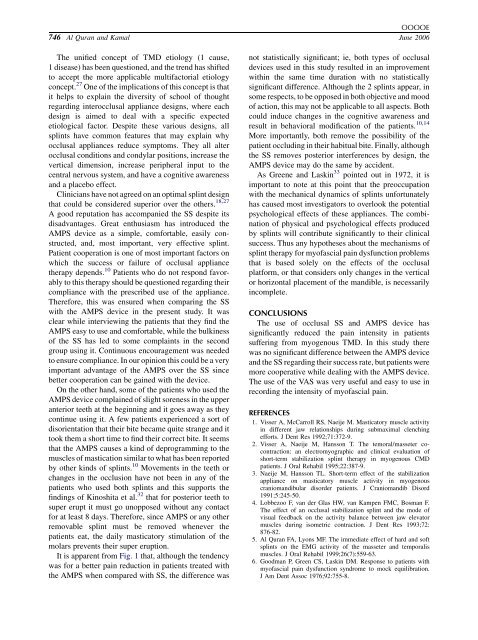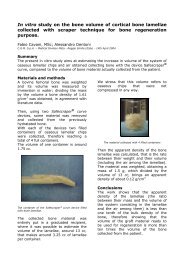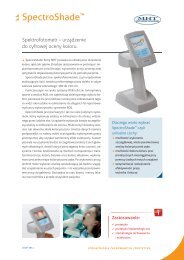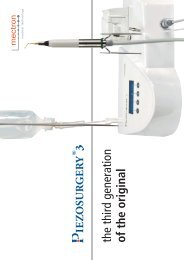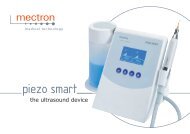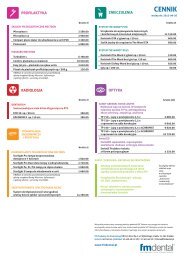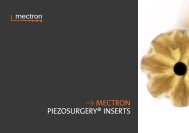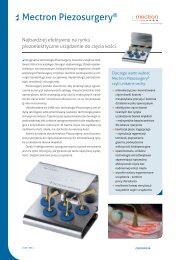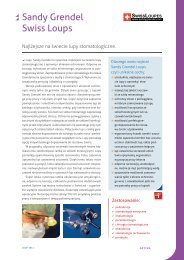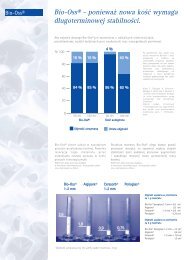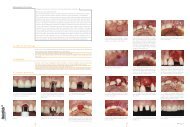Anterior midline point stop device (AMPS) in the treatment of ...
Anterior midline point stop device (AMPS) in the treatment of ...
Anterior midline point stop device (AMPS) in the treatment of ...
Create successful ePaper yourself
Turn your PDF publications into a flip-book with our unique Google optimized e-Paper software.
OOOOE<br />
746 Al Quran and Kamal June 2006<br />
The unified concept <strong>of</strong> TMD etiology (1 cause,<br />
1 disease) has been questioned, and <strong>the</strong> trend has shifted<br />
to accept <strong>the</strong> more applicable multifactorial etiology<br />
concept. 27 One <strong>of</strong> <strong>the</strong> implications <strong>of</strong> this concept is that<br />
it helps to expla<strong>in</strong> <strong>the</strong> diversity <strong>of</strong> school <strong>of</strong> thought<br />
regard<strong>in</strong>g <strong>in</strong>terocclusal appliance designs, where each<br />
design is aimed to deal with a specific expected<br />
etiological factor. Despite <strong>the</strong>se various designs, all<br />
spl<strong>in</strong>ts have common features that may expla<strong>in</strong> why<br />
occlusal appliances reduce symptoms. They all alter<br />
occlusal conditions and condylar positions, <strong>in</strong>crease <strong>the</strong><br />
vertical dimension, <strong>in</strong>crease peripheral <strong>in</strong>put to <strong>the</strong><br />
central nervous system, and have a cognitive awareness<br />
and a placebo effect.<br />
Cl<strong>in</strong>icians have not agreed on an optimal spl<strong>in</strong>t design<br />
that could be considered superior over <strong>the</strong> o<strong>the</strong>rs. 18,27<br />
A good reputation has accompanied <strong>the</strong> SS despite its<br />
disadvantages. Great enthusiasm has <strong>in</strong>troduced <strong>the</strong><br />
<strong>AMPS</strong> <strong>device</strong> as a simple, comfortable, easily constructed,<br />
and, most important, very effective spl<strong>in</strong>t.<br />
Patient cooperation is one <strong>of</strong> most important factors on<br />
which <strong>the</strong> success or failure <strong>of</strong> occlusal appliance<br />
<strong>the</strong>rapy depends. 10 Patients who do not respond favorably<br />
to this <strong>the</strong>rapy should be questioned regard<strong>in</strong>g <strong>the</strong>ir<br />
compliance with <strong>the</strong> prescribed use <strong>of</strong> <strong>the</strong> appliance.<br />
Therefore, this was ensured when compar<strong>in</strong>g <strong>the</strong> SS<br />
with <strong>the</strong> <strong>AMPS</strong> <strong>device</strong> <strong>in</strong> <strong>the</strong> present study. It was<br />
clear while <strong>in</strong>terview<strong>in</strong>g <strong>the</strong> patients that <strong>the</strong>y f<strong>in</strong>d <strong>the</strong><br />
<strong>AMPS</strong> easy to use and comfortable, while <strong>the</strong> bulk<strong>in</strong>ess<br />
<strong>of</strong> <strong>the</strong> SS has led to some compla<strong>in</strong>ts <strong>in</strong> <strong>the</strong> second<br />
group us<strong>in</strong>g it. Cont<strong>in</strong>uous encouragement was needed<br />
to ensure compliance. In our op<strong>in</strong>ion this could be a very<br />
important advantage <strong>of</strong> <strong>the</strong> <strong>AMPS</strong> over <strong>the</strong> SS s<strong>in</strong>ce<br />
better cooperation can be ga<strong>in</strong>ed with <strong>the</strong> <strong>device</strong>.<br />
On <strong>the</strong> o<strong>the</strong>r hand, some <strong>of</strong> <strong>the</strong> patients who used <strong>the</strong><br />
<strong>AMPS</strong> <strong>device</strong> compla<strong>in</strong>ed <strong>of</strong> slight soreness <strong>in</strong> <strong>the</strong> upper<br />
anterior teeth at <strong>the</strong> beg<strong>in</strong>n<strong>in</strong>g and it goes away as <strong>the</strong>y<br />
cont<strong>in</strong>ue us<strong>in</strong>g it. A few patients experienced a sort <strong>of</strong><br />
disorientation that <strong>the</strong>ir bite became quite strange and it<br />
took <strong>the</strong>m a short time to f<strong>in</strong>d <strong>the</strong>ir correct bite. It seems<br />
that <strong>the</strong> <strong>AMPS</strong> causes a k<strong>in</strong>d <strong>of</strong> deprogramm<strong>in</strong>g to <strong>the</strong><br />
muscles <strong>of</strong> mastication similar to what has been reported<br />
by o<strong>the</strong>r k<strong>in</strong>ds <strong>of</strong> spl<strong>in</strong>ts. 10 Movements <strong>in</strong> <strong>the</strong> teeth or<br />
changes <strong>in</strong> <strong>the</strong> occlusion have not been <strong>in</strong> any <strong>of</strong> <strong>the</strong><br />
patients who used both spl<strong>in</strong>ts and this supports <strong>the</strong><br />
f<strong>in</strong>d<strong>in</strong>gs <strong>of</strong> K<strong>in</strong>oshita et al. 32 that for posterior teeth to<br />
super erupt it must go unopposed without any contact<br />
for at least 8 days. Therefore, s<strong>in</strong>ce <strong>AMPS</strong> or any o<strong>the</strong>r<br />
removable spl<strong>in</strong>t must be removed whenever <strong>the</strong><br />
patients eat, <strong>the</strong> daily masticatory stimulation <strong>of</strong> <strong>the</strong><br />
molars prevents <strong>the</strong>ir super eruption.<br />
It is apparent from Fig. 1 that, although <strong>the</strong> tendency<br />
was for a better pa<strong>in</strong> reduction <strong>in</strong> patients treated with<br />
<strong>the</strong> <strong>AMPS</strong> when compared with SS, <strong>the</strong> difference was<br />
not statistically significant; ie, both types <strong>of</strong> occlusal<br />
<strong>device</strong>s used <strong>in</strong> this study resulted <strong>in</strong> an improvement<br />
with<strong>in</strong> <strong>the</strong> same time duration with no statistically<br />
significant difference. Although <strong>the</strong> 2 spl<strong>in</strong>ts appear, <strong>in</strong><br />
some respects, to be opposed <strong>in</strong> both objective and mood<br />
<strong>of</strong> action, this may not be applicable to all aspects. Both<br />
could <strong>in</strong>duce changes <strong>in</strong> <strong>the</strong> cognitive awareness and<br />
result <strong>in</strong> behavioral modification <strong>of</strong> <strong>the</strong> patients. 10,14<br />
More importantly, both remove <strong>the</strong> possibility <strong>of</strong> <strong>the</strong><br />
patient occlud<strong>in</strong>g <strong>in</strong> <strong>the</strong>ir habitual bite. F<strong>in</strong>ally, although<br />
<strong>the</strong> SS removes posterior <strong>in</strong>terferences by design, <strong>the</strong><br />
<strong>AMPS</strong> <strong>device</strong> may do <strong>the</strong> same by accident.<br />
As Greene and Lask<strong>in</strong> 33 <strong>po<strong>in</strong>t</strong>ed out <strong>in</strong> 1972, it is<br />
important to note at this <strong>po<strong>in</strong>t</strong> that <strong>the</strong> preoccupation<br />
with <strong>the</strong> mechanical dynamics <strong>of</strong> spl<strong>in</strong>ts unfortunately<br />
has caused most <strong>in</strong>vestigators to overlook <strong>the</strong> potential<br />
psychological effects <strong>of</strong> <strong>the</strong>se appliances. The comb<strong>in</strong>ation<br />
<strong>of</strong> physical and psychological effects produced<br />
by spl<strong>in</strong>ts will contribute significantly to <strong>the</strong>ir cl<strong>in</strong>ical<br />
success. Thus any hypo<strong>the</strong>ses about <strong>the</strong> mechanisms <strong>of</strong><br />
spl<strong>in</strong>t <strong>the</strong>rapy for my<strong>of</strong>ascial pa<strong>in</strong> dysfunction problems<br />
that is based solely on <strong>the</strong> effects <strong>of</strong> <strong>the</strong> occlusal<br />
platform, or that considers only changes <strong>in</strong> <strong>the</strong> vertical<br />
or horizontal placement <strong>of</strong> <strong>the</strong> mandible, is necessarily<br />
<strong>in</strong>complete.<br />
CONCLUSIONS<br />
The use <strong>of</strong> occlusal SS and <strong>AMPS</strong> <strong>device</strong> has<br />
significantly reduced <strong>the</strong> pa<strong>in</strong> <strong>in</strong>tensity <strong>in</strong> patients<br />
suffer<strong>in</strong>g from myogenous TMD. In this study <strong>the</strong>re<br />
was no significant difference between <strong>the</strong> <strong>AMPS</strong> <strong>device</strong><br />
and <strong>the</strong> SS regard<strong>in</strong>g <strong>the</strong>ir success rate, but patients were<br />
more cooperative while deal<strong>in</strong>g with <strong>the</strong> <strong>AMPS</strong> <strong>device</strong>.<br />
The use <strong>of</strong> <strong>the</strong> VAS was very useful and easy to use <strong>in</strong><br />
record<strong>in</strong>g <strong>the</strong> <strong>in</strong>tensity <strong>of</strong> my<strong>of</strong>ascial pa<strong>in</strong>.<br />
REFERENCES<br />
1. Visser A, McCarroll RS, Naeije M. Masticatory muscle activity<br />
<strong>in</strong> different jaw relationships dur<strong>in</strong>g submaximal clench<strong>in</strong>g<br />
efforts. J Dent Res 1992;71:372-9.<br />
2. Visser A, Naeije M, Hansson T. The temoral/masseter cocontraction:<br />
an electromyographic and cl<strong>in</strong>ical evaluation <strong>of</strong><br />
short-term stabilization spl<strong>in</strong>t <strong>the</strong>rapy <strong>in</strong> myogenous CMD<br />
patients. J Oral Rehabil 1995;22:387-9.<br />
3. Naeije M, Hansson TL. Short-term effect <strong>of</strong> <strong>the</strong> stabilization<br />
appliance on masticatory muscle activity <strong>in</strong> myogenous<br />
craniomandibular disorder patients. J Craniomandib Disord<br />
1991;5:245-50.<br />
4. Lobbezoo F, van der Glas HW, van Kampen FMC, Bosman F.<br />
The effect <strong>of</strong> an occlusal stabilization spl<strong>in</strong>t and <strong>the</strong> mode <strong>of</strong><br />
visual feedback on <strong>the</strong> activity balance between jaw elevator<br />
muscles dur<strong>in</strong>g isometric contraction. J Dent Res 1993;72:<br />
876-82.<br />
5. Al Quran FA, Lyons MF. The immediate effect <strong>of</strong> hard and s<strong>of</strong>t<br />
spl<strong>in</strong>ts on <strong>the</strong> EMG activity <strong>of</strong> <strong>the</strong> masseter and temporalis<br />
muscles. J Oral Rehabil 1999;26(7):559-63.<br />
6. Goodman P, Green CS, Lask<strong>in</strong> DM. Response to patients with<br />
my<strong>of</strong>ascial pa<strong>in</strong> dysfunction syndrome to mock equilibration.<br />
J Am Dent Assoc 1976;92:755-8.


